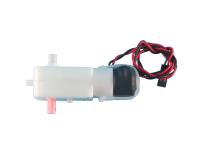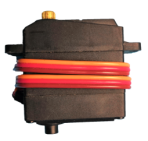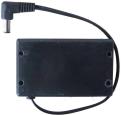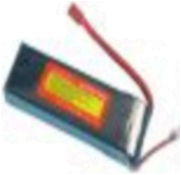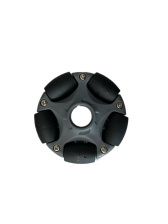Explorer Intelligent Robot Comprehensive Innovation Design CompetitionExplorer Intelligent Robot Comprehensive Innovation Design Competition 1. Competition theme Intelligent robots are one of the important application directions of artificial intelligence, and artificial intelligence technology affects important aspects of robots' decision-making, perception, and motion control. The main purpose of the Explorer Intelligent Robot Comprehensive Innovation Design Competition is to build an innovation platform for the application of artificial intelligence technology in robots, guide students to understand artificial intelligence technology in depth, and cultivate students' artificial intelligence technology practice and innovation capabilities. The competition adopts an open-ended proposition format, and the team can choose one of the following 10 questions as the direction of the work. 1. Mirror robot To make a robot that simulates human movements, there are no less than 10 degrees of freedom (except toes and fingers), and it needs to have the characteristics of a human shape, including limbs, torso, head, neck, etc. The robot can acquire and recognize the actions of characters, and can mirror at least 5 actions. 2. Drawing robot (vision) Complete a picture (can be text, pattern, photo, etc.) randomly provided by a user. The method of obtaining the picture can be imported by the user, or automatically taken by a robot or other methods of automatically obtaining the picture. 3. Visual rapid sorting robot In traditional production lines, product sorting is carried out manually, which is not only inefficient but also has a high probability of error. In order to solve the problems of highly structured and poor flexibility of the sorting operation on the production line, the robot can be equipped with a vision system. The question structure must use the Delta robotic arm. 4. Gestures imitating robots To complete a robot that can simulate gestures, the robot must have the characteristics of a human hand with no less than 10 degrees of freedom. The robot can acquire and recognize hand movements and can complete at least 5 actions. 5. Intelligent Bionic Robot To be a biomimetic robot, with no less than 8 degrees of freedom, it must move in a foot-like gait, can be remotely controlled to complete inspection tasks, and has certain environmental recognition capabilities. 6. Smart AGV The AGV is equipped with an automatic guidance system (laser guided AGV, inertial navigation, visual guidance, etc.), which can ensure that the system can automatically drive along a predetermined route without manual piloting, and automatically transport goods or materials from the starting point To the destination. 7. Wheel-legged robot Make a bionic robot with no less than 8 degrees of freedom, with omnidirectional motion, and expandable intelligent functions such as vision and navigation. 8. All-terrain field exploration robot Through sand, rocks, grass and other terrain, it can complete remote control field exploration missions and bring back mission targets. Intelligent functions such as task target recognition, autonomous navigation and outdoor positioning can be expanded. 9. Intelligent guide robot Autonomous power intelligent blind guide robot, a kind of intelligent robot designed for blind people with blind guide aids, guides the blind person to move forward through the blind cane, guides the blind person to complete obstacle avoidance, steering, straight ahead and other actions, and performs corresponding voice broadcast or other blind persons Receivable tips. 10. Pet escort robot With the development of the times, the range of pets is very wide, including animals and plants. As an opportunity for human beings to get close to nature, keeping pets can meet the psychological needs of humans. It is a very healthy and normal hobby. It is used for viewing, companionship, and relieving people's mental stress. But now most pets are more at home alone, and the safety and companionship of pets have also become issues that breeders need to consider. It is possible to design a pet escort robot, which has a certain degree of fun, and can interact with pets in games, feed and so on. Keepers can remotely observe the status of their pets in real time. 1. Competition item design requirements The participating teams should adopt the "Explorer" modular innovative component equipment design and production according to the competition requirements provided by the competition organizing committee. The main parts and components that make up the work shall not exceed the scope of the "Explorer" modular innovation component equipment (see "Attachment A: Description of the Use Scope of Parts" for details). 2. Participants Undergraduate, junior college and postgraduate students at home and abroad Three, submission requirements The following information is required for this competition. The overall information is packaged and compressed into .zip format, and the compressed package name format is "School-College-Team Name-Captain Name", such as "XX University-School of Mechanical Engineering-Explorer Team-XXX". Full-featured video of the physical model of the entry (within 120 seconds, mpg or rmvb format is required, and the file does not exceed 50M); The recording and broadcasting video of the announcement of the entry works within 3 minutes. The content includes but not limited to the introduction of the work, the introduction of the team members, and the introduction of the production process. The PDF document of the design description of the work, including text, pictures, etc. (the program description must include the program flow file), and the length is limited to 10 pages of A4 paper. (4) The program file of the work, the prototype model diagram in STP format, and the PCB processing circuit diagram if the electronic module designed by yourself is provided. 1. Scoring rules
1. The principle of no award If each team “failed to complete the game” during the competition, they will not participate in the awards, that is, they will not win. Circumstances deemed "failure to complete the game" include: (1) Damage to the playing field and cause safety accidents; (2) Disobey the discipline of the competition field and interfere with others' participation; (3) Participants are not qualified for the competition; (4) The production materials do not meet the requirements of the competition; (5) Other circumstances determined by the referee expert group. *The final interpretation of this rule belongs to the competition organizing committee. Appendix A: Description of the scope of parts 1. Allowable structural parts 1. The main parts and components that make up the work should not exceed the scope of the "Explorer" modular innovative component equipment, and any structural parts in the "Explorer" series of equipment can be used; 2. Outsourcing of structural parts is not allowed, but a certain proportion of self-processed parts (including modified "Explorer" parts) are allowed, and the quantity does not exceed 10% of the total number of "Explorer" aluminum-magnesium alloy parts that constitute the work. 2. Permitted mechanical accessories 1. All mechanical accessories such as screws, nuts, bushings, studs, washers, transmission shafts, gears, couplings, etc. configured in the "Explorer" series equipment can be used; 2. Non-slip nuts, anti-loose pads, bearings and other auxiliary assembly are allowed, and the number is not limited. 3. Allowed electronic components 1. All electronic components configured in the "Explorer" series of equipment can be used; 2. It is not allowed to use purchased electronic modules, but it is allowed to use breadboards, universal boards and component parts to make electronic modules other than the main control board, and the number shall not exceed 10% of the total number of electronic modules constituting the work. 3. Do not use main control board modules other than the "Explorer" series. "Explorer" series main control board modules include Basra main control board, bigfish expansion board, mehran main control board, arduino mega2560 main control board, SH-ST expansion board, SH-SR expansion board, Raspberry Pi, RT-STM01 main Control board. 4. Allowable motors and batteries
4. Permitted tires and tracks
6. Allowable auxiliary materials Allows the use of paper, insulating tape, transparent tape, double-sided tape, Velcro, cable tie, screw glue, rubber band, plasticine and other auxiliary assembly |
